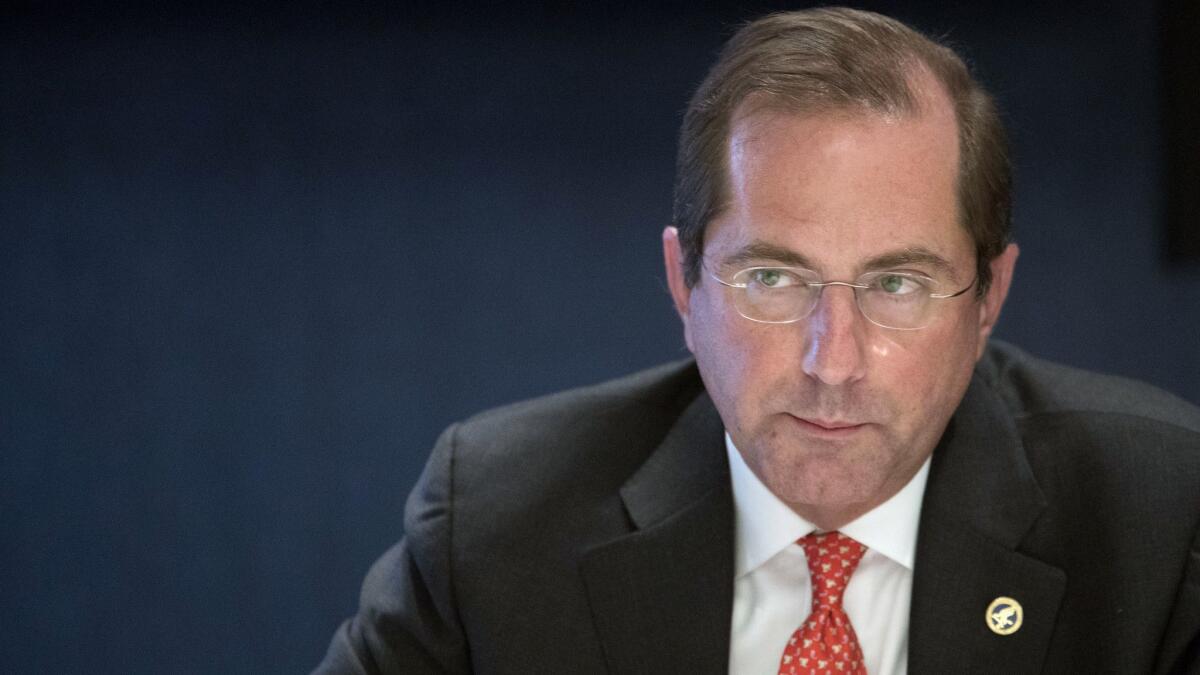Column: Obamacare premiums are coming down — and Trump deserves the blame

- Share via
About a week ago, Alex Azar, the secretary of Health and Human Services, gave credit to President Trump for bringing down premiums on Obamacare plans.
“The president who was supposedly trying to sabotage the Affordable Care Act has proven better at managing it than the president who wrote the law,” he crowed to an audience in Tennessee.
There are only two possible explanations for this remark. One is that Azar has developed into a perfect example of the species sycophantus Trumpus. The other is that he’s lost the ability to do math.
Here’s the truth underlying Azar’s remark. Yes, in some states average premiums for Affordable Care Act plans will be lower next year than in 2018. But in every state, they would be even lower if not for the concerted campaign of sabotage waged by Trump and abetted by his Republican handmaidens in Congress since 2017.
The president who was supposedly trying to sabotage the Affordable Care Act has proven better at managing it than the president who wrote the law.
— Health and Human Services Secretary Alex Azar
That’s the conclusion to be drawn from several sources, including surveys by the Kaiser Family Foundation, the Brookings Institution and state insurance commissioners.
The elements of the sabotage campaign have been well documented. They include the shrinking of the annual open enrollment period to six weeks from three months, starting last year; the expansion of access to cheaper short-term junk insurance plans that don’t cover preexisting conditions; and the near-total elimination of federal funding for outreach, information and education programs that would help prospective enrollees understand the effect of those changes.
The most significant change is the elimination of the individual mandate penalty starting in 2019; that will reduce the cost of going without health insurance to zero (not counting the cost of getting sick or injured without coverage).
At Brookings, healthcare fellow Matthew Fiedler projected that 2019 premiums would fall by an average of 4.3% in a “stable” environment — in which those Trumpian changes didn’t happen. On average, however, they’re coming in at about a 3.26% increase, according to a running tally by ACA expert Charles Gaba. (Those increases are for unsubsidized customers; those whose income makes them eligible for subsidies may see smaller increases or no increases.)
In many states rates will come down for next year, but not as much as they would without Trump’s thumb on the scale. In Tennessee, where Azar offered his fact-challenged boast, rates will fall by 10.8% on average for next year, Gaba calculates. But they would have come down by 22.8% without the sabotage. The difference in hard dollars for the average unsubsidized Tennessee enrollee, Gaba reckons, would be $1,156 for the year.
Some insurers have broken out the effects of the sabotage explicitly to distinguish them from premium changes due to traditional factors such as increases in healthcare costs.
Kaiser Foundation Health Plan of Washington, for example, which is seeking a nearly 30% premium increase next year for the more than 100,000 members of its ACA plan, cites an expected sharp increase in the morbidity, or illness profile, of the insured population, with “the complete repeal of individual mandate penalties [as] the main driver.” That will result in “some healthier consumers choosing to go without coverage,” increasing the underlying risks, and therefore costs, of the Washington healthcare market.
Healthcare experts expected 2019 premiums to rise only modestly or even come down under normal or stable conditions. That’s because many insurers reacted to uncertainties built into the Affordable Care Act or injected by Trump by requesting and receiving especially steep premium hikes for 2018. Once the situation shook out, it became evident that those increases were excessive, and would have to be adjusted back down in 2019.
Indeed, as was reported last week by the Kaiser Family Foundation (which is unaffiliated with the Kaiser health plans), Obamacare insurers have been recording gratifyingly strong financial results this year. Average gross margins per enrollee, for example, soared in the second quarter, which ended June 30, to $155.70 from $38.28 in the same period two years earlier. (The gross margins may not translate directly into profits, Kaiser Family Foundation observes, since they don’t take administrative overhead into account.)
Premium increases, meanwhile, have outpaced increases in claims handily, according to Kaiser Family Foundation, rising 23% in the second quarter over the year-earlier period, while claims increased only 10%. But the foundation also noticed a disquieting trend in 2018 figures — average hospital stays crept up in the second quarter to 27 days per 1,000 members from 25.3 days a year earlier. That was the first increase since 2015, when ACA plan enrollments began, and could signify that the ACA population is getting sicker, exactly as one would expect from the Trump sabotage campaign.
Trump and the Republicans don’t want anyone to know this, so they’ve shielded their attack on the Affordable Care Act and the public’s healthcare behind a bodyguard of lies. Trump offered one of the most flagrant lies of this campaign just last week, when he claimed at a rally in Minnesota that “some of the Democrats have been talking about ending preexisting conditions.”
He meant ending protection for people with preexisting conditions, but that doesn’t make it any less of a lie. The truth is that the Trump administration withdrew its defense of the ACA in a federal lawsuit brought by red states aimed at declaring the law’s protection for those people unconstitutional. The provisions are now being defended by a coalition of attorneys general from, yes, Democratic-controlled states.
Keep up to date with Michael Hiltzik. Follow @hiltzikm on Twitter, see his Facebook page, or email [email protected].
Return to Michael Hiltzik’s blog.
More to Read
Inside the business of entertainment
The Wide Shot brings you news, analysis and insights on everything from streaming wars to production — and what it all means for the future.
You may occasionally receive promotional content from the Los Angeles Times.











